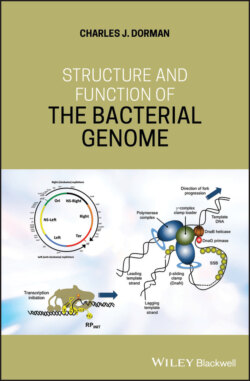Читать книгу Structure and Function of the Bacterial Genome - Charles J. Dorman - Страница 19
1.8 Resolving Chromosome Dimers
ОглавлениеThe creation of chromosome dimers by homologous recombination between sister chromosomes threatens to interfere with chromosome segregation at cell division. The dimers are resolved by site‐specific recombination at the dif sites within the terminus regions of the cointegrated chromosomes. These sites are arranged as directly repeated sequences in the dimer, albeit 4.6 million base pairs apart, and dif synapsis, strand exchange, and resolution separate the chromosome copies as monomeric molecules (Figure 1.8). The XerC and XerD tyrosine integrases act sequentially at dif to catalyse the reaction (Lesterlin et al. 2004; Sherratt et al. 1995); XerC creates the Holliday junction but this will collapse to substrate unless XerD completes the reaction (Barre et al. 2000; Hallet et al. 1999; Recchia and Sherratt 1999). The FtsK cell division protein triggers XerC/D‐mediated dimer resolution at dif (Steiner et al. 1999). FtsK is located at the cell division septum at the mid‐cell where it uses ATP hydrolysis to activate chromosome dimer resolution. Its location at the septum is dependent on its interaction with the FtsZ septum ring protein (Dorazi and Dewar 2000a; Yu et al. 1998; Wang and Lutkenhaus 1998). FtsK moves DNA within the cell, assists sister chromosome synapsis and reduces DNA entanglement/catenation of sister chromosomes (Sherratt et al. 2004). FtsK Orienting Polar Sequences (KOPS) located near the dif site in the Ter region of the chromosome contribute to the directional loading of the FtsK translocase, allowing it to segregate the daughter chromosome by driving a copy into each daughter cell (Bigot et al. 2006, 2007; Sivanathan et al. 2009; Stouf et al. 2013). The dif site and the wider Ter region of the chromosome remain in close association with the septum/nascent septum throughout the cell cycle (Niki et al. 2000).
Figure 1.8 Resolution of a chromosome dimer by XerCD‐mediated recombination at dif. Chromosome dimerisation can occur as a result of recombination‐mediated DNA repair during replication. The dimers are resolved by site‐specific recombination at two directly repeated dif sites located in the Ter region. The reaction is catalysed by the XerCD tyrosine integrases, generating monomeric chromosomes that can be segregated into the two daughter cells at cell division.
It is not in the interest of the bacterium to have chromosome dimers arising frequently because this poses a risk that either anucleate cells will arise or that the chromosome may be damaged by the division septum as the cell attempts to segregate a dimeric chromosome. RecA‐dependent homologous recombination events, whether they arise via the RecBCD or RecFOR pathways (Section 1.6), generate Holliday junctions that must be resolved by the Ruv resolvasome‐based system. There is a bias in this process in favour of Ruv‐mediated resolution that does not involve crossover, and therefore the creation of chromosome dimers (Cromie and Leach 2000; van Gool et al. 1999). This bias reduces the frequency at which chromosome dimers, and the associated threat to the wellbeing of the daughter cell genomes, arise.
The XerCD system is versatile and is used in site‐specific recombination reactions with sequences related, but not identical, to dif, and accompanied by co‐factor proteins, to resolve dimers in autonomously replicating plasmids (Clerget 1991; Colloms 2013; Colloms et al. 1990, 1998; Summers 1989). In the human pathogen V. cholerae, the CTXφ bacteriophage that carries the cholera toxin ctxAB operon integrates into chromosome I at its dif site using the XerC recombinase from the V. cholerae XerCD recombinases to catalyse the reaction (it can enter the corresponding location on chromosome II at a lower frequency) (Das et al. 2013; Huber and Waldor 2002; McLeod and Waldor 2004). CTXφ is a filamentous phage and only the plus strand of its genome integrates. The plus strand of the CTXφ genome folds to create a double‐stranded region that encompasses the XerC and XerD binding sites of the phage flanking a mismatched and bulging phage dif site. Only a single stranded exchange occurs, mediated by XerC alone, and this creates a Holliday junction that is resolved by DNA replication (Val et al. 2005). The minus strand of the CTXφ, phage fails to generate a dif site with enough homology to recombine with the chromosomal counterpart, so this strand of the phage genome does not integrate. The integrated phage does not excise because its dif sites also lack sufficient homology with the chromosomal site to promote site‐specific recombination (Val et al. 2005).
